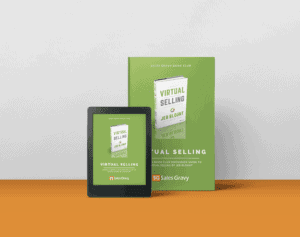
Finding Sales Success During The Pandemic With The Telephone
Written By: Seth Kinney
Reaching Prospects During The Pandemic
Despite COVID making it more difficult for salespeople to get in touch with prospects and decision-makers, one follow-up and outreach approach has proved more effective than any other method— the telephone.
If your company is like most, your sales team has had to make some major changes to the way they reach out to prospects. In-person events disappeared, much of the workforce moved to work-from-home, and you’re competing for attention against pandemic-sized distractions.
For our team, which typically generates over 10,000 sales appointments per year for our B2B technology clients, many of our old tactics simply didn’t work well once COVID-19 hit.
But, surprisingly, one type of prospect outreach actually started working better for us: good old-fashioned phone calls.
Before we get into how we shifted to a more phone-heavy approach, let’s talk about how we knew we needed to make the change in the first place.
Plummeting Email Response Rates
Yes, historically, email has a 2x higher ROI than cold calling. But in our experience, email response rates have been at an all-time low in the COVID era.
When their traditional work environments were upended, many sales teams were unprepared for the virtual shift. They didn’t have access to the right data to continue calling and, as a result, their sales touchpoint cadence became very email-heavy. With a set-it-and-forget-it approach to lead follow-up, automation took its course, and the market became desensitized, deleting most messages sight unseen.
We’ve seen reply rates on emails dip below 1% since COVID’s impact gripped the US.
Since we couldn’t rely on email as much, we started to lean on the phone. It was still a multi-channel sales touchpoint process, just with a lot more calls.
Breaking The Phone Sales Stigma
Over the last year, I’ve heard a lot of pushback from people saying it’s become increasingly difficult to contact prospects by phone. With many people transitioning to work-from-home, it’s a lot harder to reach them now. Makes sense, right?
Not so fast.
As mentioned above, many sales teams weren’t prepared to make the virtual shift themselves, but there are two key reasons the phone proved more effective:
- Many people have their office numbers forwarded to their cells, so reaching them with current contact information has not been as big of an issue as some expect.
- We’ve been using tools like True People Search and our own proprietary database of over 50,000 business-tech buyers to source mobile numbers.
Sure, it will always be difficult to gain traction using the phone for unsolicited sales calls — but when the phone becomes an integral part of your lead follow-up process, it can supercharge your conversions.

The shift to virtual has transformed the way we sell. You and your team can discover how to engage more prospects & customers, in less time, at a lower cost, while reducing the sales cycle with our FREE Virtual Selling Book Club Guide.
Triple-Touch Follow-Up Process
Start by creating a lead follow-up schedule that identifies your touchpoints — when and how you’ll be contacting your leads. Typically, it takes between 8-12 touchpoints over various communication channels to engage with a lead. Today, given the circumstances and market shifts, we’re seeing that closer to 12-20.
Our sales development team, for example, has perfected a cadence of 24-touchpoints in their lead follow-up process that uses a blend of LinkedIn, phone, and email.
The process goes something like this:
Start immediately with a triple-touch approach.
- A quick LinkedIn message to further educate and build trust and credibility early. This shouldn’t be a sales-heavy message, just a soft CTA.
- Immediately follow-up with a phone call. LinkedIn can be a slow-developing channel depending on how often the prospect checks their account. It’s a good start, but getting them on the phone ASAP is the ultimate goal.
- If there’s no answer on the call, leave a voicemail and follow up with an email.
From here the process gets phone-heavy, averaging 3-4 calls per every email you send.
The entire 24-point process consists of about 5 emails and a LinkedIn message or two. The rest are phone calls.
The Best Way To Follow-Up By Phone
During the process, you’ll find the right mix of communication. When relying heavily on phone follow-up, it’s all about a persistent and consistent approach.
There’s an art and science to it, really. Throughout the 24-point lead follow-up process, SDRs should make a call and leave a voicemail if there’s no answer. Then they should wait 36 hours before following-up with a ‘quick touch’ call (a call with no voicemail). Wait another 24 hours, rinse. and repeat.
Ultimately, it’s important to strike a balance between giving leads time to respond and being persistent so they don’t move on to another service provider. As long as you continue to be professional, build trust, and educate along the way, most B2B prospects (especially any inbound leads) will respect and appreciate your staying top-of-mind with regular follow-ups.
When To Call vs. Send An Email
This depends on a few factors. We’ve stressed the importance and success of lead follow-up via phone for a reason—80% of Inside Sales Solutions’ success in booking appointments with qualified prospects for our clients comes over the phone.
But there are times when an email-centric follow-up approach is appropriate and can be effective. When your prospect’s motivation is high, a timely email follow-up is all it takes to further qualify the lead and keep them progressing through the funnel.
Only start the follow-up process with email when there has already been some education done. Despite the declining email numbers during the pandemic, an engaged customer is an engaged customer. If the lead info comes as a result of a demo, trial, or consultation request, email follow-up is very much appropriate.
For many of these types of requests, sales development teams have an auto email function in place that immediately deploys to schedule a follow-up appointment based on the specific request. Just be wary of relying too heavily on automation.
When To Make Contact
People are busy — especially decision-makers. That’s why it’s important to time your outreach according to your prospect’s schedule. It just doesn’t make sense to perform hundreds of calls during lunchtime or during peak meeting hours.
If you don’t have any insight into how your prospects spend their day, figure out their time zone then plan to call them between 9 and 11 a.m. or 3 to 5 p.m. From our experience, these are the most optimal times, but your experience might vary based on your industry and goals.
Bottom Line: Embrace The Phone
To sum up, events over the past year have forced many sales teams to shift their lead follow-up touchpoint strategies. As social selling and email have started to show diminishing returns (even if only temporarily), SDRs were left with the phone.
If your team isn’t comfortable dialing it up, it’s time to get them trained up.
Create sales call scripts, do some role-playing, and go over tactics and rebuttals for handling objections and rejections. Stress the importance of active listening, building rapport, and closing on the call.
Because 9 times out of 10, the phone is your best bet to seal the deal.
About the author
Seth Kinney
Seth is a results-driven sales leader with over 20 years of experience in inside…
Get FREE Sales Training Delivered to Your Inbox
Join more than 360,000 professionals who get our weekly newsletter.
Related Articles

Learn Online
Self-paced courses from the
world's top sales experts

Virtual Training
Live, interactive instruction in small
groups with master trainers

Coaching
One-to-one personalized coaching
focused on your unique situation






